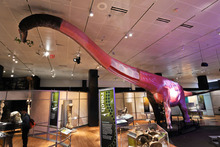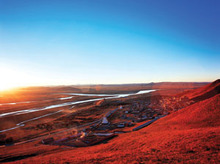Meet Mamenchisaurus
Part of the The World's Largest Dinosaurs exhibition.
The centerpiece of our exhibition is Mamenchisaurus hochuanensis (Mah-MEN-chi-SAWR-us ho-CHOO-an EN-sis). As you explore the website you'll discover her both as she looked in life, and as she would have looked had scientists been able to peer inside her body.
Each view holds clues to a fascinating scientific question: How did these dinosaurs get so big?

How Big Was She?
30 ft (9 m): neck length.
11 ft (4m): height at shoulder.
60 ft (18 m): total length.
She was 18 years old.
She weighed 13 tons (about 12,000 kg), ate 1,150 lbs (525 kg) of food per day, and had no predators as an adult.
She lived in what is now China.

What Distinguishes Her?
One hundred and sixty million years ago the animal spanning this room, Mamenchisaurus hochuanensis, lived in what is now China. Mamenchisaurs were not the largest sauropods, and--immense as she is--our specimen is not the largest mamenchisaur. She and her relatives have at least one big distinction, though: they have the longest necks for their body size of any dinosaur known.
Dinosaur Beds
The Sichuan Basin of China contains most of the known fossils of the sauropod group called Mamenchisauridae. Remains of some seven species, all large and long-necked, have been found in deposits dating back some 160 million years in this region and elsewhere in China.
A Dinosaur Timeline
